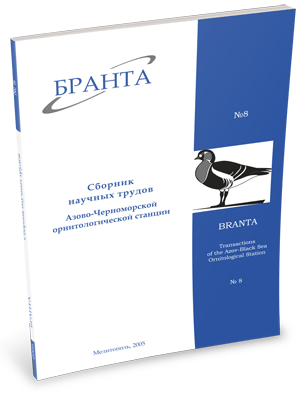
Transactions
of the Azov-Black Sea Ornithological Station



Biocoenotical links between vegetation and colonially breeding representatives of Pelecaniformes and Ciconiiformes on the Lebyazhy Islands
N.A. Bagrikova, S.Yu. Kostin
A distinctive feature of Ciconiiformes colonies on the Lebyazhy Islands is that they have formed long before formation of analogical Sivash complexes and differ from them as well as from colonies of the north near Azov area with other rate of islands isolation, vegetation structure and hydrochemical parameters. The paper pays chief attention to characteristics of habitat distribution of colonies of Pelecaniformes and Ciconiiformes, and surrounding-forming value of Cormorant (Phalacrocorax carbo) on the LebyazhyIslands.
Material of this paper is based on investigations, carried out on the LebyazhyIslands in 1997-2000. Flora composition and distribution of vegetation assemblages were studied by traditional methods applying for flora and geobotany investigations (according to dominant principle). Characteristics of distribution of colonies of Ciconiiformes and Pelecaniformes were studied with a help of large-scale mapping (Александрова, 1964; Воронов, 1964). Material on birds was gathered during absolute counts of bird numbers in colonies according to standard methods (Черничко, Сиохин и др., 1993).
A wormwood assemblage with projective cover degree not less 40% originally presented on the control site. But being under press of nest-building activity of the Cormorant this assemblage was almost destroyed in the first year of the colony existence. Having gone through a number of successional changes and as a result of heavy nitrification of the substrate, the vegetation in the first spring was presented by monospecies dense growth of the orach with a projective cover degree of 100% and height up to 1.5 m. During the second spring after active washout of the nitrogen through the shelly substrate there were registered low-size ephemerous plants that finished their growth before late June. With the plants dying out the site (with area circa 300 m2) turned into bare shelly ground with solitary plants presented.
The considerable impact of the Cormorant on the islands biocoenoses through active transformation of vegetation will finally lead to impoverishment of coenotic structure of island complexes (perennial plants are displaced by annual ones), extraction of some species from their traditional habitats (Great Black-headed Gull, Caspian Tern) that indirectly will help to decrease their area.
Read the paper in a PDF file